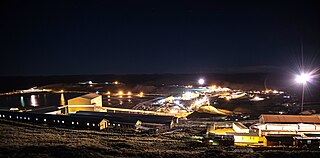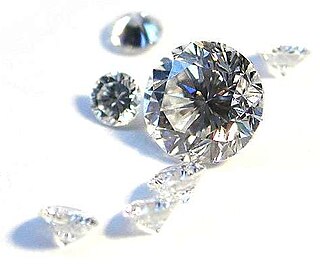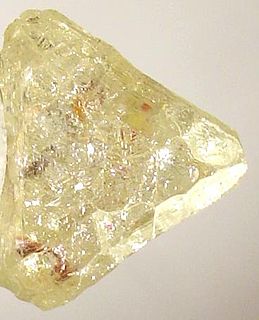
Diamond is a solid form of the element carbon with its atoms arranged in a crystal structure called diamond cubic. At room temperature and pressure, another solid form of carbon known as graphite is the chemically stable form of carbon, but diamond almost never converts to it. Diamond has the highest hardness and thermal conductivity of any natural material, properties that are utilized in major industrial applications such as cutting and polishing tools. They are also the reason that diamond anvil cells can subject materials to pressures found deep in the Earth.

Crater of Diamonds State Park is a 911-acre (369 ha) Arkansas state park in Pike County, Arkansas, in the United States. The park features a 37.5-acre plowed field, the world's only diamond-bearing site accessible to the public. Diamonds have continuously been discovered in the field since 1906, including the Strawn-Wagner Diamond. The site became a state park in 1972 after the Arkansas Department of Parks and Tourism purchased the site from the Arkansas Diamond Company and Ozark Diamond Mines Corporation, who had operated the site as a tourist attraction previously.

The Argyle Diamond Mine is a diamond mine located in the East Kimberley region in the remote north of Western Australia. Argyle was at times the largest diamond producer in the world by volume, although the proportion of gem-quality diamonds was low. It is the only known significant source of pink and red diamonds, and additionally provided a large proportion of other naturally coloured diamonds, including champagne, cognac and rare blue diamonds.

The Letlhakane diamond mine is a diamond mine located in Botswana about 190 kilometers (120 mi) west of the city of Francistown. Letlhakane, meaning "little reeds", is owned by Debswana, a partnership between the De Beers company and the government of Botswana. It is the second oldest of four mines operated by the company, having begun operations in 1975.

The Jwaneng diamond mine is the richest diamond mine in the world and is located in south-central Botswana about 120 kilometers (75 mi) west of the city of Gaborone, in the Naledi river valley of the Kalahari. Jwaneng, meaning "a place of small stones", is owned by Debswana, a partnership between the De Beers company and the government of Botswana. It is the second newest of four mines operated by the company, having begun operations in 1982.

The Merlin diamond mine is one of only three diamond mines in Australia. The mine is located in the Northern Territory of Australia, about 80 kilometres south of Borroloola. The mine operated for a period of about three years from 2000 to mid-2003, during which time it produced about 500,000 carats (100 kg) of high quality diamonds.

The Murowa diamond mine is a diamond mine located in Mazvihwa, south central Zimbabwe, about 40 kilometres from the asbestos mining town of Zvishavane in the Midlands province. The mine is majority owned and operated by the Rio Tinto Group, which also owns the Argyle diamond mine in Australia and part of the Diavik Diamond Mine in Canada. The mine is a combination of open pit and underground construction; current estimates put construction costs at $61 million USD and mine reserves are 19 million tonnes of ore, with an ore grade of 0.9 carats (180 mg) per tonne.
The Luarica diamond mine is a diamond mine located in Angola. The mine is owned by a consortium of diamond mining companies, the two largest holders being Endiama with 38 percent ownership and Trans Hex with 32 percent ownership.

The Catoca diamond mine is the fourth largest diamond mine in the world, and is located in Angola. The mine is owned by a consortium of international mining interests, including Endiama, Alrosa of Russia (32.8%), Odebrecht of Brazil (16.4%), and the Diamond Finance CY BV Group (16.8%). The mine is located on a kimberlite pipe.

The Williamson Diamond Mine is a diamond mine 23 kilometres (14 mi) northeast of Shinyanga in Tanzania; it became well known as the first significant diamond mine outside of South Africa. The mine was established in 1940 by Dr. John Williamson, a Canadian geologist, and has been continuous operation since then, making it one of the oldest continuously operating diamond mines in the world. Over its lifetime it has produced over 19 million carats (3,800 kg) of diamonds. A 2020 report by The Guardian said that high-quality pink diamonds from the mine could value up to $700,000 a carat.

Harry Winston was an American jeweler. He donated the Hope Diamond to the Smithsonian Institution in 1958 after owning it for a decade. He also traded the Portuguese Diamond to the Smithsonian in 1963 in exchange for 3,800 carats of small diamonds.
The Star of South Africa, also known as the Dudley Diamond, is a 47.69-carat (9.538 g) white diamond found by a Griqua shepherd in 1869 on the banks of the Orange River. The original stone, before cutting, weighed 83.5 carats (16.70 g). The finding of this large diamond led to diamond prospectors coming to the area, culminating in the July 1871 rush to the nearby new diamond field at Colesberg Koppje, soon known as New Rush, and later to be known as Kimberley.

The Letšeng Diamond Mine, found in the landlocked Southern African kingdom of Lesotho, is owned by Gem Diamonds, Ltd. and the government of Lesotho, and at an elevation of 3,100 m (10,000 ft) it is the world's highest diamond mine.

Diamond is one of the best-known and most sought-after gemstones. They have been used as decorative items since ancient times.

The Mining industry of Ghana accounts for 5% of the country's GDP and minerals make up 37% of total exports, of which gold contributes over 90% of the total mineral exports. Thus, the main focus of Ghana's mining and minerals development industry remains focused on gold. Ghana is Africa's largest gold producer, producing 80.5 t in 2008. Ghana is also a major producer of bauxite, manganese and diamonds. Ghana has 20 large-scale mining companies producing gold, diamonds, bauxite and manganese, and, there are also over 300 registered small scale mining groups and 90 mine support service companies.
Mining in Angola is an activity with great economic potential since the country has one of the largest and most diversified mining resources of Africa. Angola is the third largest producer of diamonds in Africa and has only explored 40% of the diamond-rich territory within the country, but has had difficulty in attracting foreign investment because of corruption, human rights violations, and diamond smuggling. Production rose by 30% in 2006 and Endiama, the national diamond company of Angola, expects production to increase by 8% in 2007 to 10,000,000 carats (2,000 kg) annually. The government is trying to attract foreign companies to the provinces of Bié, Malanje and Uíge. Angola has also historically been a major producer of iron ore.

Petra Diamonds Ltd is a diamond mining group headquartered in Jersey. It has a diversified portfolio, with interests in eight producing mines in South Africa and Tanzania and an exploration programme in Botswana. Petra Diamonds' focus has shifted from exploration to production, becoming one of the largest independent producers of diamonds in Africa. In June 2012, Petra owns 5 of the world's most productive mines historically. These mines include the Cullinan Diamond Mine famed for having produced the world's largest rough and polished diamond. It is listed on the London Stock Exchange.

The Wittelsbach-Graff Diamond is a 31.06-carat (6.212 g) deep-blue diamond with internally flawless clarity originated from the Kollur Mine, India. Laurence Graff purchased the Wittelsbach Diamond in 2008 for £16.4 million. In 2010, Graff revealed he had had the diamond cut by three diamond cutters to remove flaws. The diamond was now more than 4 carats (800 mg) lighter and was renamed the Wittelsbach-Graff Diamond. There is controversy, as critics claim the recutting has so altered the diamond as to make it unrecognisable, compromising its historical integrity.

Kelsey Lake Diamond Mine is a defunct diamond mine in Colorado, USA. It is located in the State Line Kimberlite District, near the Wyoming border, and consists of nine kimberlite volcanic pipes, of which two were open pit mined.

The Eureka Diamond was the first diamond discovered in South Africa. It originally weighed 21.25 carats (4.250 g), and was later cut to a 10.73-carat (2.146 g) cushion-shaped brilliant, which is currently on display at the Mine Museum in Kimberley. The discovery of diamonds in South Africa led to the Kimberley Diamond Rush, and marked the beginning of the Mineral Revolution.
















